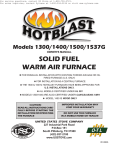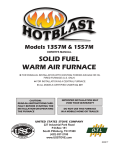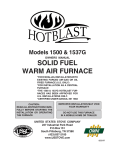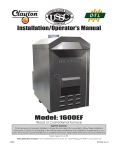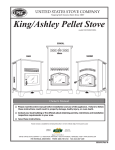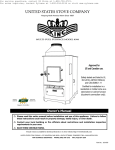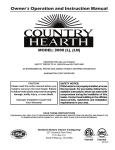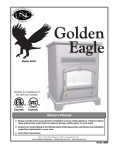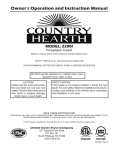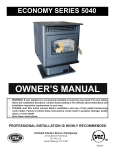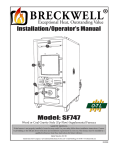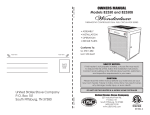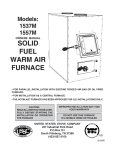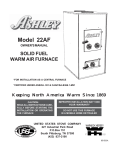Download United States Stove 2500 Owner`s manual
Transcript
Models VG1500/VG2500 OWNER'S MANUAL SOLID FUEL WARM AIR FURNACE FOR PARALLEL INSTALLATION WITH EXISTING FORCED AIR-GAS OR OIL FIRED FURNACE (U.S. ONLY) FOR INSTALLATION AS A CENTRAL FURNACE THE VG2500 FURNACE HAS BEEN APPROVED FOR U.S. INSTALLATIONS ONLY. ALL MODELS CERTIFIED UNDER UL 391-2010 MODELS VG1500 IS ALSO CERTIFIED UNDER CSA-B366.1-11 SAVE THESE INSTRUCTIONS CAUTION: READ ALL INSTRUCTIONS CAREFULLY BEFORE STARTING THE INSTALLATION OR OPERATING THE FURNACE IMPROPER INSTALLATION MAY VOID YOUR WARRANTY DO NOT USE THIS FURNACE IN A MOBILE HOME OR TRAILER UNITED STATES STOVE COMPANY 227 Industrial Park Road South PIttsburg, TN 37380 PH.: (800) 750-2723 • www.Vogelzang.com PORTLAND, OREGON, USA LISTED BY OMNI-Test Laboratories, Inc. Report Number 215-S-07c-4 VG2500 (Certified for US only) LISTED BY PORTLAND, OREGON, USA OMNI-Test Laboratories, Inc. Report Number 215-S-07c-4 VG1500 (Certified for US and Canada) 852057 CONGRATULATIONS! You've purchased one of America's Finest Wood and Coal Burning Furnaces. By heating with wood and coal you're helping CONSERVE AMERICA'S ENERGY! Wood is our Renewable Energy Resource. Please do your part to preserve our wood supply. Plant at least one tree each year. Future generations will thank you. NOTE: YOUR UNIT MUST BE INSTALLED BY A QUALIFIED FURNACE INSTALLER. TOOLS AND MATERIALS NEEDED MATERIAL TOOLS Pencil 6 Foot Folding Rule or Tape Tin Snips Drill, Hand or Electric Drill Bit- 1/8" Dia. (For Sheet Metal Screws) Screw Driver (Blade-Type) Gloves Sabre Saw 5/16" Nut Driver or 5/16" Socket w/Ratchet Safety Glasses 6" Pipe, 6" Elbow, Collar and Thimble; as required (24 gauge min.) 1/2" Sheet Metal Screws 6" Inside diameter Listed Residential Type or Building Heating Appliance Chimney or existing masonry chimney Electrical Wiring 6" Draft Regulator 1/2" Conduit (Conduit Connectors) Furnace Cement (Manufacturer Recommends: Rutland Black-Code 78 or Equivalent) Plenum and Duct work as required. 2 Caution Labels Your Furnace has the following labels. Read and Obey all labels. DANGER: RISK OF FIRE OR EXPLOSION. DO NOT burn garbage, gasoline, drain oil, or other flammable liquids. WARNING: FIRE HAZARD. DO NOT operate with fire draft exceeding .06 inches w.c. DO NOT operate with fuel loading or ash removal doors open. DO NOT store fuels, paints, thinners, flammable liquids, or other highly volatile substances in the furnace room. CAUTION: HOT SURFACES! Keep children away. Do not touch during operation. CAUTION! INSPECT FLUE PIPES, FLUE PIPE JOINTS AND FLUE PIPE SEALS REGULARLY TO ENSURE THAT SMOKE AND FLUE GASES ARE NOT DRAWN INTO, AND CIRCULATED BY, THE AIR CIRCULATION SYSTEM. CAUTION! CLEANOUT OF THE HEAT EXCHANGER, FLUE PIPE, CHIMNEY, AND DRAFT INDUCER (IF USED), IS ESPECIALLY IMPORTANT AT THE END OF THE HEATING SEASON TO MINIMIZE CORROSION DURING THE SUMMER MONTHS, CAUSED BY ACCUMULATED ASH. SAFETY NOTICE: If this heater is not properly installed, a house fire may result. For your safety, follow the installation directions. Contact local building or fire officials about restrictions and installation inspection requirements in your area. If not already installed, we recommend that smoke detectors be installed. 3 Rules for safe installation and operation Read these rules and the instructions carefully. Failure to follow them will cause a hazard that could result in death, serious bodily injury, and/or property damage. 1. Check your local codes. The installation must comply with their rulings. retained in the closed container until all cinders have thoroughly cooled. Other waste shall not be placed in this container. 2. Do not install this furnace in a mobile home or trailer. 13.CAUTION- The special paints used on your furnace may give off some smoke while they are curing during first few fires., Build small fires at first. The metal used in construction of the furnace and duct work has a light coating of oil. This could give off smoke and/ or odor from registers when furnace is used for the first time. This should disappear after a short period of time. Once this burn-off has occurred, it should not reoccur. 3. Always connect this furnace to a chimney and vent to the outside. Never vent to another room or inside a building. 4. Do not connect this furnace to an aluminum Type B gas vent. This is not safe and is prohibited by the National Fire Protection Association Code. This furnace requires a masonry or Listed Factory Built Chimney for residential type or Building Heating Appliance Chimney. Use a 6" diameter chimney or larger, that is high enough to give a good draft. 14.CARING FOR PAINTED PARTS- This furnace has a painted outside jacket, which is durable, but it will not stand rough handling or abuse. When installing your furnace, use care in handling. Clean with soap and warm water when furnace in not hot. DO NOT use any acids or scouring soap, as these wear and dull the finish. DISCOLORATION WILL OCCUR IF THE FURNACE IS OVERHEATED. FOLLOW OPERATING INSTRUCTIONS CAREFULLY. 5. Be sure that if a masonry chimney is used, it is safely constructed and in good repair. Have the chimney inspected by the Fire Department or an inspector. 6. Inspect chimney connector and chimney before and frequently during the heating season for any deposit of creosote or soot which must be removed. 7. Provide air for combustion into the room where the furnace is located. If the intake is not in the same room, air must have free access to the room. 15.Keep the feed and ash doors closed at all times except while tending the furnace. 16. WARNING: RISK OF FIRE - Inspect and clean flues and chimney regularly CAUTION: Hot surfaces CAUTION: Keep children away CAUTION: Do not touch during operation CAUTION: Maximum draft marked on nameplate 8. CAST IRON PARTS MUST BE "SEASONED" TO AVOID CRACKING, BUILD ONLY SMALL FIRES ON FIRST USE. 9. To prevent injury, do not allow anyone to use this furnace who is unfamiliar with the correct operation of the furnace. CAUTION 10.For further information on using your furnace safely, obtain a copy of the National Fire Protection Association (NFPA) publication "Chimney's, Fireplaces and Solid Fuel Burning Appliances" NFPA 211. The address of the NFPA is Batterymarch Park, Quincy, MA 02269. GASES THAT ARE DRIVEN FROM FRESH COAL MUST BE BURNED OR THEY WILL ACCUMULATE AND EXPLODE. NEVER SMOTHER A FIRE WHEN ADDING FRESH COAL. CAUTION DO NOT OPERATE WITH THE FEED AND/OR ASH DOOR OPEN. THIS FURNACE IS DESIGNED FOR THERMOSTATIC OPERATION. OPERATION WITH ANY OF THESE DOORS OPEN WILL OVERHEAT AND DAMAGE THE FURNACE. 11.Keep the ashpit section free of excess ashes. Do not allow ashes to stack higher than the sides of the ash pan. CAUTION 12. Disposal of Ashes – Ashes should be placed in a steel container with a tight fitting lid and moved outdoors immediately. The closed container of ashes should be placed on a noncombustible floor or on the ground, well away from combustible materials, pending final disposal. If the ashes are disposed of by burial in soil or otherwise locally dispersed, they should be NEVER USE GASOLINE, GASOLINE-TYPE LANTERN FUEL, KEROSENE, CHARCOAL LIGHTER FLUID, OR FLAMMABLE LIQUIDS TO START OR "FRESHEN UP" A FIRE IN THE FURNACE. WARNING NEVER STORE FLAMMABLE LIQUIDS, ESPECIALLY GASOLINE, IN THE VICINITY OF THE FURNACE. Your Furnace is designed to be installed in a parallel air flow arrangement with a gas or oilfired forced air upflow-type central furnace, or it may be installed as a central furnace. 4 HOW THE FURNACE FUNCTIONS Your furnace is designed to be a supplemental or central heating source for your home. This Solid Fuel Furnace may be installed in conjunction with a properly operating central furnace that is listed or certified in accordance with nationally recognized safety standards and equipped with the required controls and other safety features and which has been installed in accordance with appropriate standards of the National Fire Protection Association with installation clearances specified in the furnace nameplate marking. The installation must be accomplished by a qualified agency (one who is engaged in, and is responsible for, or is thoroughly familiar with the installation and operation of the gas, oil, and solid fuel burning heating appliances, who is experienced in such work, familiar with all the requirements of the authority having jurisdiction.) The installation shall be in strict accordance with the manufacturer's installation instructions furnished with the solid fuel furnace. The chimney connector of the furnace is to be installed to provide clearances to combustible material not less than specified in the individual classifications and marked on the furnace. The chimney connector must be connected to a chimney suitable for use with residential type or building heating appliances which burn solid fuel. The Furnace is designed to operate in either parallel or series air flow arrangement with the central furnace or as a central furnace. CENTRAL FURNACE INSTALLATION: As a central furnace, the unit functions independently of any other system. The blower will come on when the plenum temperature reaches the setting on the blower control. 5 PARALLEL INSTALLATION: (U.S. ONLY) The design is such that when the blower comes on, the blower on the central system also comes on. The blower will only come on when the temperature in the plenum has reached the setting on the blower control. This is to insure that there is sufficient warm air in the system to make it efficient for the unit to operate. When the central system thermostat calls for heat, the central system will operate by the burner igniting and the blower coming on. It is possible that both systems will operate simultaneously. It is recommended that for the most efficient use of your furnace, that it be fired as much as possible in order to reduce the demand on your existing central heating system. This unit has an optional forced draft kit that operates from a wall thermostat. When the temperature falls below the setting on the wall thermostat, the forced draft will come on (U.S. Stove Option 11/DIKL) The warm air supply outlet of the furnace shall not be connected to the cold air return of the central furnace, because the possibility exists of components of the central furnace overheating and causing the central furnace to operate other than is intended. SERIES INSTALLATION: This type of installation uses only the blowers of the existing central furnace. The solid fuel fan/ limit control must also control the functions of the existing furnace. All electrical power must come from a single branch circuit. DIMENSIONS OF FURNACE Figure 1 Model VG1500 Figure 2 Models VG2500 6 Locating the Furnace 1. The furnace should be located in the same room as the central system and as close as possible, but not closer than 9". There should be no wall between the furnace and the warm air outlet duct that is connected directly to the warm air outlet plenum of the central furnace. (See Fig. 4) 18" 21" 12" 9" 2. Place the furnace on a noncombustible floor. 3. Check figures 3 through 5. Be sure you have the clearances shown below from the furnace and the connector pipe to combustible surfaces. If you have a solid brick or stone wall behind your furnace, you can place the furnace as close as you wish to the wall. If the wall is only faced with brick or stone, treat it as a combustible wall. VG1500 CENTRAL FURNACE 48" Figure 4 VG2500 Unit to Sidewall 12" 12" (305mm) (305mm) Unit to Backwall 30" 30" (760mm) (760mm) Front of Unit to Combustible 48" (1.22m) Chimney Pipe to Sidewall 18" 21" (460mm) (530mm) Chimney Pipe to Backwall 18" 18" (460mm) (460mm) Plenum to Combustibles 6" 6" (150mm) (150mm) PLENUM TO 6" MIN. CEILING 6" CHIMNEY 18" 6" SOLID DAMPER 48" (1.22m) 6" BAROMETRIC DRAFT REGULATOR 18" 2" MIN. AIR SPACE REQUIRED BY CODE NON-COMBUSTIBLE FLOOR Figure 5 CENTRAL FURNACE Figure 3 7 Chimney Connection MASONRY CHIMNEY Before using an existing masonry chimney, clean the chimney and inspect the flue liner to be sure it is safe to use. Make repairs before attaching the furnace. The connector pipe and fittings you will need to connect directly to a masonry chimney are shown. THIMBLE 6" ELBOW 6" BAROMETRIC DRAFT REGULATOR The chimney connection should be as short as possible. 6" CHIMNEY CONNECTOR If the connector pipe must go through a combustible wall before entering the masonry chimney, consult a qualified mason or chimney dealer. The installation must conform to local fire codes, and N.F.P.A. 211. NON-COMBUSTIBLE WALL 6" SOLID DAMPER 6" ELBOW DO NOT CONNECT THIS FURNACE TO A CHIMNEY FLUE SERVING ANOTHER APPLIANCE. The chimney used for a furnace must not be used to ventilate the cellar or basement. If there is a cleanout opening at the base of the chimney, close it tightly. Figure 6 LISTED FACTORY BUILT CHIMNEY 2' MIN. Carefully follow chimney manufacturer's instructions. Use only a Listed Residential Type or Building Heating Appliance Chimney. If your chimney starts at the ceiling (Fig. 7), you will need enough 6" pipe to reach the ceiling. 10' The top of the chimney must be at least 3 feet above the roof and be at least 2 feet higher than any point of the roof within 10 feet (Fig. 7). 3' MIN. REFER TO CHIMNEY MANUFACTURER'S INSTRUCTIONS AND PARTS. 6" SOLID DAMPER 6" BAROMETRIC DRAFT REGULATOR 6" CHIMNEY CONNECTOR 6" ELBOW Figure 7 8 Rules for Connector Pipe Installation 1.The crimped end of the chimney connector fits inside the furnace flue collar. Install additional chimney connectors and elbow with the CRIMPED END TOWARD THE FURNACE. This will allow any condensation in the flue to run back into the furnace. Use 6" dia. steel pipe and elbows for connection to chimney. Never use less than 24 gauge and although blued steel is satisfactory, high temp painted black is much more desirable. (See Figure 8) 2. Slope any horizontal pipe upward toward the chimney at least 1/4 inch for each foot of horizontal run. 3.You must have at least 18 inches of clearance between any horizontal piping and the ceiling.(See Fig. 5) 4.The chimney connector must not extend into the chimney flue. (See Fig. 9) 5. Seal each chimney connector pipe joint with furnace cement. Also seal the pipe at the chimney. 6. Use 3 sheet metal screws at each chimney pipe joint to make the piping rigid. 7.The chimney connector may include a section for a barometric draft regulator between the furnace and the chimney (Fig. 6, 7, & 10). The barometric draft regulator must be installed in the same room (same pressure zone) as the furnace. 8. Install the barometric draft regulator strictly in accordance with the instructions that are provided with the barometric draft regulator. NOTE: A flue pipe shall not pass through an attic, roof space, closet or similar concealed space, a floor or ceiling of combustible construction. Where passage through a wall or partition is desired, installation must conform with UL standards. Figure 8 RIGHT 9. A solid damper must be used in the chimney connecting pipes between the flue collar and the chimney. When used in conjunction with a barometric draft regulator, the solid damper must be placed between the barometric and the chimney. (See Fig. 6, 7, & 10) Adjusting the Barometric Draft Regulator 1.Drill a hole in the chimney connector within 18" of the flue collar below the barometric draft regulator just large enough for the tube of the manometer. 2.Build a fire after all chimney connections have been made. 3.Use a manometer to measure the draft in the flue. 4.Adjust the Barometric Draft Regulator to obtain a draft of 0.05 - 0.06" W.C. under stable fire conditions. 9 WRONG WRONG Figure 9 NON COMBUSTIBLE INSTALLATION PER NFPA 211 6" SOLID DAMPER 6" BAROMETRIC DRAFT REGULATOR MEASURE FLUE DRAFT HERE Figure 10 CONNECTION OF CHIMNEY CONNECTOR TO A MASONRY CHIMNEY THROUGH A COMBUSTIBLE WALL Figure 8 shows how to connect the chimney connector of a heater to a masonry chimney through a combustible wall. There are five allowable ways that a chimney connector can be connected to a masonry chimney by passing through a combustible wall. NFPA Standard 211 allows the following wall pass-through systems. Figure 11 10 FIGURE 12, PART A MINIMUM CHIMNEY CLEARANCE TO BRICK AND COMBUSTIBLES IS 2 IN. CHIMNEY FLUE MINIMUM CLEARANCES 12 IN. OF BRICK ALL AROUND MINIMUM 12 IN. TO COMBUSTIBLES CHIMNEY CONNECTOR TO HEATER FIRE CLAY LINER (5/8" MIN. WALL THICKNESS) MASONRY CHIMNEY CONSTRUCTED TO NFPA 211 MIN. 3-1/2" THICK BRICK MASONRY WALL 1.Use a minimum 3-1/2" thick brick masonry wall framed into the combustible wall. A fireclay liner (ASTM C315 or equivalent) having a 5/8" minimum wall thickness must be used and it must be at least 12" away from any material that could catch fire. The inside diameter of the fireclay liner shall be sized for the proper snug fit of a 6" diameter chimney connector pipe. The fireclay liner shall run from the outer surface of the brick wall to, but not beyond, the inner surface of the chimney flue and shall be firmly cemented in place. See Part A. FIGURE 12, PART B NONSOLUBLE REFACTORY CEMENT AIR SPACE 9 IN. MINIMUM AIR SPACE FACTORY-BUILT CHIMNEY LENGTH CHIMNEY FLUE MINIMUM CHIMNEY CLEARANCES FROM MASONRY TO SHEET STEEL SUPPORTS AND COMBUSTIBLES 2 IN. CHIMNEY LENGTH FLUSH WITH INSIDE OF FLUE MINIMUM CLEARANCE 9 IN. ALL AROUND CHIMNEY CONNECTOR TO HEATER USE CHIMNEY MFRS. PARTS TO ATTACH CONNECTOR SECURELY SOLID INSULATED, LISTED FACTORY-BUILT CHIMNEY LENGTH MASONRY CHIMNEY CONSTRUCTED TO NFPA 211 SHEET STEEL SUPPORTS (24 GAUGE MIN. THICKNESS) 2.Use a solid insulated listed factory-built chimney length having an inside diameter of 6" and having 1" or more of solid insulation. There must be at least a 9" air space between the outer wall of the chimney length and any combustible materials. The inner end of the chimney length shall be flush with the inside of the masonry chimney flue and shall be sealed to the flue and to the brick masonry penetration with nonwater-soluble refractory cement. Sheet steel supports which are at least 24 gauge (0.024") in thickness shall be securely fastened to wall surfaces on all sides. Fasteners between supports and the chimney length shall not penetrate the chimney liner. See Part B. FIGURE 12, PART C MINIMUM CHIMNEY CLEARANCES FROM MASONRY TO SHEET STEEL SUPPORTS AND COMBUSTIBLES 2 IN. 24 GAUGE VENTILATED THIMBLE WITH TWO 1 INCH AIR CHANNELS CHIMNEY FLUE CHIMNEY THIMBLE TWO VENTILATED AIR CHANNELS EACH 1 INCH. CONSTRUCTED OF SHEET STEEL. MASONRY CHIMNEY CONSTRUCTED TO NFPA 211 CHIMNEY CONNECTOR TO HEATER MINIMUM 6 IN. GLASS FIBER INSULATION ALL AROUND SHEET STEEL SUPPORTS (24 GAUGE MIN. THICKNESS) 3.Use a 10" diameter ventilated thimble made of at least 24 gauge (0.024") steel having two 1" air channels. The ventilated thimble must be separated from combustible materials by a minimum of 6" glass fiber insulation. The opening in the combustible wall shall be covered and the thimble supported with sheet steel supports which are at least 24 gauge (0.024") in thickness. The sheet steel supports shall be securely fastened to wall surfaces on all sides and shall be sized to fit and hold the chimney section. Fasteners used to secure chimney sections shall not penetrate chimney flue liner. See Part C. 11 MINIMUM CHIMNEY CLEARANCES FROM MASONRY TO SHEET STEEL SUPPORTS AND COMBUSTIBLES 2 IN. FIGURE 12, PART D SHEET STEEL SUPPORTS MINIMUM CLEARANCE 2 IN. ALL AROUND CHIMNEY SECTION 1 IN. AIR SPACE TO CHIMNEY LENGTH CHIMNEY THIMBLE CHIMNEY CONNECTOR TO HEATER CHIMNEY FLUE CHIMNEY CONNECTOR AIR SPACE 2 IN. MASONRY CHIMNEY CONSTRUCTED TO NFPA 211 SOLID INSULATED, LISTED FACTORY-BUILT CHIMNEY LENGTH (12 IN. LONG MIN.) SHEET STEEL SUPPORTS (24 GAUGE MIN. THICKNESS) 4.Use an 8" inside diameter solid insulated listed factory-built chimney length which has 1" or more of solid insulation. The minimum length of this chimney section shall be 12" and will serve as a pass-through for the 6" diameter chimney connector. There must be at least a 12" air space between the outer wall of the chimney section and any combustible materials. The chimney section shall be concentric with and spaced 1" away from the chimney connector by means of sheet steel support plates on both ends of the chimney section. The opening in the combustible wall shall be covered and the chimney section supported on both sides with sheet steel supports which are at least 24 gauge (0.024") in thickness. The sheet steel supports shall be securely fastened to wall surfaces on all sides and shall be sized to fit and hold the chimney section. Fasteners used to secure chimney sections shall not penetrate chimney flue liner. See Part D. 5.A listed factory-built wall pass-through system may be purchased and installed according to the instructions packaged with it to provide a safe method of passing the chimney connector through a combustible wall for connection to a masonry chimney. Additional requirements pertaining to Figure 8 and the above wall pass-through systems: 1.Insulation material used as part of wall pass-through system shall be of noncombustible material and shall have a thermal conductivity of 1.0 Btu • in./ft.² • °F (4.88 kg • cal/hr • m² • °C) or less. 2.All clearances and thicknesses are minimums: larger clearances and thickness are acceptable. 3.A chimney thimble, as shown for 3" and 4" above (Parts C and D) shall be for types "3" and 4" connections to facilitate removal of the chimney connector for cleaning. The chimney thimble shall be of ASTM C315 fireclay with 5/8" minimum wall thickness, or material or equivalent durability. The inside diameter of the thimble shall be sized for the proper snug fit of a 6" diameter chimney connector pipe. The thimble shall be installed without damage to the chimney flue. The thimble shall extend through the chimney wall to, but not beyond, the inner surface of the chimney flue and shall be permanently cemented in place with high temperature cement. 4.A chimney connector to a masonry chimney, except for 2" above (Part B), shall extend through the wall pass-through system to the inner face of the chimney flue, but not beyond. It does not have to be fastened in place so long as it cannot accidently be pulled out of the chimney or shoved into the chimney flue. If fasteners are used to secure the chimney connector to a masonry chimney, the fasteners shall not penetrate the chimney flue liner. 5.Any material used to close up any opening for the connector shall be noncombustible. PART E - (Figure 12) In addition to the methods shown by A, B, C, and D of Figure 12, a listed factory-built wall pass-through system may be purchased and installed according to the instructions packaged with it to provide a safe method of passing chimney connector through a combustible wall for a connection to a masonry chimney. CONNECTION OF CHIMNEY CONNECTOR TO A MASONRY CHIMNEY WHEN CHIMNEY CONNECTOR DOES NOT PASS THROUGH A COMBUSTIBLE WALL If the chimney connector does not have to pass through a combustible wall to get to a masonry chimney, simply connect the chimney connector directly to the masonry chimney's chimney thimble as described and shown by parts C and D of Figure 12. Remember, the chimney connector should extend into the chimney thimble to the innerface of the chimney flue but not beyond; if the chimney connector is extended through the chimney thimble into the chimney flue, resistance to the flow of smoke and gases up the chimney will occur; that flow resistance will have an adverse affect on the operation and performance of the heater and venting system. 12 Assembly of Furnace 2 Your furnace requires the following items to be assembled or installed by the service person: Feed Door Pull Handle Feed Door Locking Handle Blowers and Blower Controls Electrical Connections 1 B B A A 1.Remove all parts from inside the furnace and inspect for damage, including the firebrick as some breakage could occur during shipment. 2.Assemble the feed door pull handle as shown in Figure 13. Install thermostat assembly and cover (complete with handle) as illustrated in Figure 13b. 3. Align thermostat control knob with flat on thermostat control shaft and press onto shaft. (See Fig. 13a) 2 Figure 13b 1 4.Attach feed door locking handle as in Figure 14 with screws and nuts provided. Note: Slotted holes are for adjustment of handle. Adjust handle until some pressure is required to lock feed door during firing sequence. 5.Install the thermodisc on rear of furnace cabinet with the two screws provided. Mount the conduit assembly from the junction box to the thermostat bracket. Crimp the two female terminals to each of the wire leads. Plug the wires to the thermodisc. NOTE: It does not matter which of the two wires plugs to which terminal on the thermodisc. 6. Remove blowers from cartons. Remove junction box cover. Attach clip nuts as in Figure 15. Install blower(s) and gasket(s) with 1/4"-20 x 3/4" bolts as shown. 7. Wire right side blower first (See wiring diagram) and replace cover on junction box on blower. Figure 14 THERMODISC THERMODISC COVER 4” ELECTRICAL JUNCTION BOX 8. Wire left blower same as above and replace cover. 9. Check operation of shaker grates with grate handle before operating furnace. SET SCREW BLOWERS BLOWERS GASKET Figure 13a CLIP NUTS (Not used in the upper center hole.) Figure 15 13 (Model VG1500 has only one blower) WIRING DIAGRAM Figure 16 NOTE: For model VG1500, disregard the wiring (wires M1 & M2) of one blower motor. Wire leads from the distribution blower are usually BOTH BLACK. Makes no difference which leads from the motor(s) connects to the corresponding leads coming out of the conduit. 14 Installation Please see all methods of Installation at the rear of this booklet. This is a furnace, not a free standing stove. You must direct heated air from 8" outlets away from the furnace, or it will not function properly. 1. This installation must be done by a qualified heating equipment installer. 2.The installation is to be done in compliance with National Fire Protection Association installation standards: No. 89M, 90B, 211, 70 (National Electrical Code) and Uniform Mechanical Code 913, 6-4, in the states where applicable. (Their code offers connecting smoke pipe connectors into chimney with other fuel burning appliances.) 3.Rooms large in comparison with size of the appliance: a) Wood or Coal Burning Furnace needs air for combustion and circulation to house. b)Provision must be made to make up this air and not starve gas or oil furnace of combustion air. c) Have the "Authority Having Jurisdiction" determine that air is of adequate makeup. (Reference N.F.P.A. Nos. 30&54, Code for Installation of Gas & Oil Equipment). 4. Have the "Authority Having Jurisdiction" to inspect all chimneys and installations for adequate venting and for compliance with standard and local codes and regulations regarding installation of wood burning appliances. 5.Installation for Supplemental Heat Application to Existing Central System. a) Place Wood or Coal Burning Furnace so that the chimney connector will be as short as practical and avoiding unnecessary sharp turns in the smoke pipe connector and the installation of devices that would create excessive resistance to the flow of flue gases. d)Install the smoke pipe connector to the chimney with 26-gauge pipe and elbows (to be purchased separately), maintaining the proper clearances for the specific model. Seal the smoke pipe in the chimney with furnace cement. (The chimney connector shall be securely supported, and joints fastened with sheet metal screws or rivets.) e)Install 8" diameter heat pipe to plenum of the central hot air furnace. Use 26-gauge pipe and connectors (to be purchased separately). If central air conditioning is installed in the plenum, install heat pipe above the air conditioning unit. Secure heat pipe connection with supports and sheet metal screws. f) Connect electrical supply in the electrical junction box that is mounted on the back of the Furnace. See Wiring Diagram (Fig. 16). Remove the cover from electrical junction box and connect power supply wires to wires designated, using wire nuts. The power cord supplied may be used for installation, if permitted by local codes and regulations. If the power cord supplied cannot be used, the power supply wiring must be 90 degrees centigrade in a metal cable and should be completed by a qualified installer complying with NFPA Standard No. 70 and local codes. 6) The warm-air supply-duct system be constructed of metal in accordance with NFPA 90B, 2-1.1 7) The plenums installed to the furnaces shall be constructed of metal in accordance with NFPA 90B, 2-1.3 8) If fans are used in the fuel storage area, they must be installed so as not to create negative pressure in the room where the solid- fuel burning appliance is located. 9) The maximum combustion air damper setting is "HIGH" Caution: Do not alter the automatic combustion air damper for increased firing for any reason. b)Locate the Wood or Coal Burning Furnace as close as practical to the existing central hot air heating system, maintaining clearances as stated on the label on the fuel door. Power Failure Instructions c) Clearance from combustible materials must comply with those stated on the label on the side of the unit. Refer to the clearance table in the front of this manual. 2.Do not expect to keep home at normal temperatures. The installation must be made only on a noncombustible floor. 15 Operation after loss of power: 1.Remove filter if provided 3.Do not load fuel above bottom of feed door. Operating Instructions FLUE If the flue-draft setting is exceeded it could cause a solid fuel fire to burn out of control. FUEL Egg size (1-3/16" or larger) bituminous coal for residential furnaces, or any of the specially packed fireplace coals can be used. Coal with a low ash content (2% to 6%) is recommended. Hardwood, 18" to 26" should be split and air dried (seasoned) for 6 months. DO NOT USE CHEMICALS OR FLUIDS TO START THE FIRE. DO NOT BURN GARBAGE, GASOLINE, NAPHTHA, ENGINE OIL, OR OTHER INAPPROPRIATE MATERIALS. DO NOT STORE FUEL WITHIN THE APPLIANCE INSTALLATION CLEARANCES OR WITHIN THE SPACE FOR FUELING, ASH REMOVAL, AND OTHER ROUTINE MAINTENANCE. LIGHTING 1.Set the thermostat on "HIGH" for maximum draft. 2.Open the feed door and place paper and kindling on the grate for starting the fire. 3.Light the fire and close the feed door. 4.Add wood or about 15 lbs. of coal (depending on which model) after fire is burning briskly. 5."MEDIUM" setting is normally satisfactory. Set higher or lower for your comfort. ADDING FUEL When starting a fire, add small amounts of fuel instead of adding large quantities of fuel. This will give more complete combustion and less build-up of tars or soot in the chimney. A small intense fire is preferable to a large smoldering one to reduce the amount of creosote deposition. 1.Set thermostat to HIGH before opening feed door. 2.Wood fire: Add wood to a convenient level. 3.Coal Fire: a.) Never smother the fire when adding coal. Gases from the accumulation smoke will explode under certain conditions. Add fresh kindling if the bed of coals has cooled. b.) Add up to 20 lbs. of coal per loading. Never add coal above the bottom of feed door opening. c.) Stir the coal and watch the fire. Be sure the new coal is burning briskly before you close the doors and turn the thermostat down. d.) Shake grates vigorously 1/2" left to right to spill ashes into the ash pan. Do this at least once every 12 hours of operation. Empty ash pan regularly. Do not allow ashes to build-up to grate as grate will warp and burnout, and you might spill the ashes when removing the pan. Dispose of hot ashes properly. e.) Rotation of the handle (5 o'clock to 7 o'clock) position will agitate coals and spill ashes into ash pan. f.) It is advisable for you to get familiar with the shaker grate operation before firing. 16 4.If the chimney is operating too cool, water will condense in the chimney and run back into the furnace. Creosote formation will be rapid and may block the chimney. Operate the furnace at a high enough fire to keep the chimney warm, preventing this condensation. Service Hints Do not expect a furnace to draw. It is the chimney that creates the draft. Smoke spillage into the house or excessive build-up of water or creosote in the chimney are warnings that the chimney is not functioning properly. Correct the problem before using furnace. Possible causes are: 5.If the fire burns well, but sometimes smokes or burns slowly, it may be caused by the chimney top being lower than another part of the house or a nearby tree. The wind blowing over a house or a tree, falls on top of the chimney like water over a dam, beating down the smoke. The top of the chimney should be at least 3 feet above the roof and be at least 2 feet higher than any point of the roof within 10 feet. 1.The connector pipe may be pushed into the chimney too far, stopping the draft. 2.Do not connect two furnaces or a stove and furnace into the same chimney flue. 3.The chimney used for a furnace must not be used to ventilate the cellar or basement. If there is a cleanout opening at the base of the chimney, it must be closed tightly. 6.See page 18 for list of trouble shooting tips. A draft reading of .05 to .06 w.c. is suggested for proper burning of this unit when using wood or bituminous coal as fuel. When using anthracite coal, this draft reading is a minimum reading. It is necessary to keep the fuel loading and de-ashing doors closed and maintain all seals in good condition. Chimney Maintenance CAUTION Creosote and Soot - Formation and Need for Removal When wood is burned slowly, it produces tar and other organic vapors, which combine with expelled moisture to form creosote. The creosote vapors condense in the relatively cool chimney flue of a slow-burning fire. As a result, creosote residue accumulates on the flue lining. When ignited, this creosote makes an extremely hot fire. When coal is burned, the products of combustion combine with moisture to form a soot residue which accumulates on the flue lining. When ignited, this soot makes an extremely hot fire. The chimney should be inspected at least twice monthly during the heating season to determine if a creosote or soot build up has occurred. If creosote or soot has accumulated, it should be removed to reduce the risk of a chimney fire. Chimney fires burn very hot. If the chimney catches fire, immediately call the fire department, then reduce the fire by closing the inlet air control. Pour a large quantity of coarse salt, baking soda or cool ashes on top of the fire in the firebox. 17 A chimney fire may cause ignition of wall studs or rafters which you thought were a safe distance from the chimney. If you have a chimney fire, have your chimney inspected by a qualified person before using again. Solid fuel burning appliances need to be cleaned frequently because soot, creosote and ash may accumulate. The following rules should be followed to reduce the risk of soot or creosote fires: 1. Establish a routine for the storage of fuel, care of the appliance and firing techniques. 2. Check daily for creosote buildup until experience shows how often cleaning is necessary. 3. be aware that the hotter the fire, the less creosote is deposited, and that weekly cleaning can be necessary in mild weather, even though monthly cleaning can be enough in the coldest months. Trouble Shooting Tips for Warm Air Furnace 1. Problem: Smoke puffs from furnace Solution: A. Check chimney draft. Check for blocked chimney or flue pipe. Use mirror to check chimney clearance. B. Check ash pit — if it is too full, empty. C. Make sure furnace room is not too airtight. D. Make sure all of chimney mortar connections are airtight. E. Check ash drawer. Make sure it’s airtight. F. Check chimney for possible down-draft caused by taller surrounding trees or objects. Correct with proper chimney vent cap. G. Check the possibility of a cold chimney forcing cool gases backward. Remedied by properly insulating chimney with non-combustible liner — noncombustible insulation. H. Fuel may be too green. I. Make sure no other fuel burning devices are connected to the chimney impairing the draft. J. Check chimney draft, it should be .06 inches of water column. This service is provided by a certified chimney sweep. 2. Problem: Inadequate heat being delivered to your home Solution: A. Check home insulation — is it adequate? B. Check hook-up to furnace — is it installed correctly? C. Cool air inlet may be inadequate or furnace room too airtight. D. Your wood fuel may be too low grade. Hardwoods are recommended. E. Make sure your hot air duct (and other duct work) is airtight. F. If furnace room is warm but your home isn’t, check back draft dampers. G. Is air to the blower available? 3. Problem: Excess smoke or flames coming out door when refueling Solution: A. Wait 15 seconds and open door SLOWLY — then refuel. B. Check length of flue pipe to chimney. Your unit should be within six (6) feet of your chimney. C. Make sure chimney cap is not too close to the top of the chimney. E. Make sure you’re not suffocating the fire with excessive amounts of unburned wood. F. Slide baffle should be pulled out prior to load door opening. 4. Problem: Distribution blower vibrating Solution: A. Tighten blower wheel to motor shaft. B. Check for bad fan bearings. 5. Problem: Distribution blower continues to run or will not run Solution: A. Check fan limit or heat sensor and cable. B. Check to see that blower is properly wired. (See Wiring and Assembly Instructions). C. Check fuse box or power source. D. Check power supply. 6. Problem: Odor from first fire Solution: A. The odor from new steel should disappear in a few hours. B. If the odor remains, call you dealer immediately. A bad weld can cause a fume leak. 7. Problem: Excessive Creosote Solution: A. Check the grade of wood you are burning. B. Make sure your unit is serviced by its own proper chimney. C. Check length of flue pipe and its connections. D. Make sure you are burning the smallest, hottest fire to adequately heat your home. E. Also see Solutions to Problem one. 8. Problem: If the fire goes out or does not hold over night Solution: A. Poor Draft. B. Incorrect damper settings. C. Improper firing methods if burning coal. D. More combustion air needed. E. Coal not sized to the furnace. We recommend 1” to 3” diameter pieces of coal. F. Ashes, if allowed to accumulate in the ash pit, will not allow passage of the required air for combustion. Keep ash pit clean. G.This furnace is not to be used with an automatic stoker unless so certified. D. Check chimney draft — make sure chimney flue pipe is clean and chimney is of adequate height. 18 19 18 6 16 20 Repair Parts 17 VG1500 22 14 36 39 10 15 34 7 1 12 8 11 9 13 21 38 37 5 2 3 39 41 4 1 34 23 24 28 32 25 27 26 38 37 33 40 30 29 31 VG2500 19 Parts List !! NOTICE !! When ordering color painted repair parts, be sure to note the COLOR CODE at the end of the part number to ensure you receive the correctly painted parts. (i.e. 25541 H - Cabinet Side w/ Hammer Tone, Black reverse paint color) Key 1 Part No. 25541 25467 Description Cabinet Side (Left & Right) Model VG1500 VG2500 Qty. Key Part No. 2 26 80230 2 88032 Flue Collar Gasket 2 3 40246 Flue Collar 1 N/S 83227 Bolt, 1/4-20 x 1" 6 83250 Kep Nut, 1/4-20 N/S 4 5 25540 23459 25561 25466 Cabinet Back Cabinet Top 27 28 6 VG1500 VG2500 VG1500 VG2500 1 1 2 89319 83340 Description Blower Gasket, Blower 1/4-20 Clipnut N/S 83339 Bolt (1/4-20 x 3/4") 29 22140 Relay Box Bracket Model Qty. VG1500 1 VG2500 2 VG1500 1 VG2500 2 VG1500 4 VG2500 8 VG1500 4 VG2500 8 1 30 80131 Junction Box (4 x 4) 1 31 80231 Junction Box Cover 1 N/S 891214 8" Collar 6 68217 Feed Door Assy. (Includes Gasket - 88057) 1 32 80314 Thermodisc (60T12) 1 7 22662 Bracket, Feed Door 1 33 68234 Blower Thermostat Bracket 1 8 24232 Spacer, Hinge 1 9 891097 Locking Mechanism, Feed Door 1 34 89066 Firebrick (4.5 x 9 x 1.25) 10 68218 Ash Door Assy. (Includes Gasket - 88066) 1 36 40264 Liner, Front/Rear 37 40256 Grate Frame, Shaker 38 40257 Grate, Shaker 11 86626 Latch, Door 1 12 83461 Washer (1" OD, 7/16" ID) 1 13 83274 Lock Nut, 3/8-16 1 14 891098 Handle Assy. w/Handle Bushing 1 15 23859B Draft Cap, Painted 1 16 89574 Handle, Spring 2 17 23800 Smoke Curtain 1 18 23787 Clip, Smoke Curtain 2 19 83445 1/4-20 x 1-1/4 Carriage Bolt 2 20 83250 Kep Nut, 1/4-20 2 21 22 68238 68228 23397 23398 23 22761B 24 22762B 25 86402 Ash Pan Baffle, Flue Flue Collar Ring VG1500 VG2500 1 VG2500 2 1 Forced Draft Ring 1 1-1/2" Pipe Plug 1 10 VG2500 12 VG1500 2 VG1500 1 VG2500 2 VG1500 1 VG2500 2 1 39 40260 Handle, Shaker VG1500 VG2500 40 40258 Liner - Front/Rear VG2500 1 41 40269 Liner - Front VG2500 1 N/S = Not Shown Color Code: H = Hammer Tone, Black Reverse 1 VG1500 VG1500 20 Parts Diagram/List 5 6 8 3 12 1 4 7 10 A 11 7 9 13 2 4 - 68733 Thermostat Box Assembly 1 68722 Thermostat Panel Weldment 2 68732 Thermostat Cover Weldment 3 23429 Thermostat Step Plate 1 4 23431 Friction Plate 1 (Color - Hamertone Grey) - 1 (Color - Hamertone Grey) 1 5 81903 Thermostat 1 6 23427 Thermostat Mounting Bracket 1 7 83172 #10 Sheet Metal Screw 6 8 89041 Spring 1 9 89175 Thermostat Knob 1 10 23425 Handle Bracket 2 11 89520 Wooden Handle 12 86318 Thermostat Chain 1 Feed Door Assembly (Includes Door and Gasket) 1 Machine Screw, 10-24 x 1/2" SL HD Z 2 .542 FT 13 68217 N/S 83106S N/S 83136 Washer, 9/32" I.D. - 5/8" O.D. - 1/16" THK. 1 N/S 83816 Cotter Pin, 1/16" x 3/4" 1 21 3 Optional Equiptment 11DIKL Draft Inducer Kit w/ Limit Swich This optional kit allows your furnace to be thermostatically controlled and gives the option to change the on/off times of the distribution blower(s). UFB908 Universal Filter Box When installing ANY warm air furnace, proper installation is the key and required for getting the most efficiency and longest life out of your unit. Failure to install your furnace as outlined from the manufacturer, often will result in inadequate heating and problems associated with drafting. U. S. Stove Co. offers the UFB908, a universal filter box that mounts to the rear of the unit that your return air duct work will attach to. It uses a standard 16 x 20 x 1 filter (NOT INCLUDED) to reduce the amount of dust particles from being transferred thru you duct work system. 11DIKL DR-6 Barometric Damper Regulator In the unlikely event that your furnace “overfires” (a condition evidenced by elbows, stove pipes, and connectors glowing red in appearance or otherwise discoloring), then your installation is subject to excessive draft created by either a chimney too tall or too great in diameter in conjunction with its height, or some other factor of an indeterminate cause. In this event, you should install a barometric draft regulator. Such installation will preclude any over-firing and/or any hazardous consequences of potential overfiring. Barometric draft regulators are generally available where you purchased your stove or may be ordered directly from United States Stove Company at a nominal charge. UFB908 22 DR-6 Bulletin rc454 a guide to Burning coal in your furnace Furnaces that are capable of burning coal usually will burn both Bituminous and Anthracite coal. Anthracite is perhaps the best coal fuel because of its long even burn time, high heat output, and cleanliness which make it a good choice for the home. However, keep in mind it is a much more difficult fuel to use, requires more care and patience, is not so widely available, and is usually much more expensive than Bituminous. SIZE OF COAL: Most sizes of Bituminous Coal will work in a coal furnace; for best results we recommend large “nut” coal to small “egg” coal (1-3/4” diameter to 4” diameter). When burning Anthracite, use “egg” or “broken” with sizes between 2-5/16” thru 4-3/8”. Note that it is important to the long life of your stove to buy coal which has been sized and cleaned. Cleaning insures removal of rocks and other minerals. Never use coal smaller than 1” or larger than 5” in diameter. Small sized coal will smother the fire. Too large a size of coal will not burn well. STOVE OPERATION: All coal fires should be started with wood which will allow the fire to get hot enough to ignite the coal. The best ignition fires utilize dry pine or other resinous soft woods as kindling, with hard wood (oak, hickory, ash) added to increase the heat prior to addition of the coal. Before starting the fire, open the stove pipe damper (if epuipped), turn the thermostat to high, open the ash pit door and feed door, place newspaper and finely split kindling on the grate, light the paper, add larger hard wood after the kindling is burning brightly. Caution: Never use gasoline, lantern fuel, kerosene, charcoal lighter fluid, or other flammable liquids to start or freshen up a fire in any heater. Place the larger pieces of wood on the fire so that they are slightly separated and form a level for the addition of coal. It will take 10 to 20 minutes before this wood is thoroughly ignited. Adding coal too soon will cut the air supply and smother the fire. BURNING BITUMINOUS: Once your kindling and wood fire has produced a bed of well established coals, start adding coal in layers allowing each to ignite before adding more. Bituminous has a high volatile content and, as a re23 sult, should be fired with the “conical method” - with the highest portion of your fire bed in the center of the firebox. The first flames will be long and generally orange or yellow and produce quite a bit of smoke. As the gases burn off the flames become shorter, change color and produce less smoke. Once the fire is WELL ESTABLISHED add coal to the center of the firebox forming the cone. Burning in this fashion allows heat to drive off the volatile gases, and turbulence created increases the burn efficiency. There will have to be some experimenting with the individual setup as no two chimney’s or installations are going to be the same. Just remember to allow enough air to enter the firebox and keep the stove pipe damper open so that volatiles are properly burned. Before refueling, take the time to break up the cone a little with a poker, especially if it has caked over or formed a crust. But, be careful not to mix the coal as this increases the chances of forming clinkers. When shaking the grate(s) be gentle. Just a few short movements - a couple of “cranks” - is better than a lot of agitation. The objective is to remove a small amount of the ashes without disturbing the fire. Stop when you see a glow in the ashes or the first red coals fall into the ash pan. Excessive shaking wastes fuel and can expose the grate(s) to very high temperatures which can cause warpage or burnout. For overnight operation (long duration burn time) shake the fire and add coal, retaining the center cone. Once the volatiles are burned off, close the feed door and adjust the stove pipe damper, if epuipped. Then adjust the thermostat to the desired heat level. More MAINTENANCE will be needed with bituminous coal than with anthracite coal as more soot will collect on heating surfaces and in pipes, requiring more frequent cleaning. ANTHRACITE: Add a thin layer of coal (preferably smaller chunks) to the wood fire, being careful not to disturb it too much or cut off the draft. Then, add a second heavier layer after the coal is ignited and burning well. If necessary, add a third layer to bring the coal up to the top of the front liner (not above!). Be sure to close the ash door. Bulletin rc454 a guide to Burning coal in your furnace Before adding further fuel, be sure to leave a red spot of glowing coals in the center of the firebox to insure that the fire has not been smothered and to help ignite the gases given off by the new charge. A deep charge will give a more even heat and a longer fire, but it may take one to two hours before the whole bed is fully ignited. BANKING THE FIRE: For extended operation, such as overnight, the fire will need to be banked. To do so heap coal up along the sides and back of the firebox so that the fire gradually burns it over a longer period of time. The intensity of the fire will also be reduced without letting it go out. Follow the same procedure as for refueling. If possible, avoid shaking, as a heavier layer of ash will help reduce the intensity of the fire during this time. After loading, let the fire establish itself for about 30 minutes. Then close your damper and automatic control to the point where the house does not become too cold. It is important that you begin banking early enough before retiring or leaving that you can make necessary adjustments after the fire is well established. When the fire is well established and the room is becoming warm, partially close the dampers. Some experimenting will have to take place with each particular setting of all dampers and controls as the chimney provides the draft necessary to not only exhaust the smoke, but to pull combustion air into the heater as well - and no two chimney’s perform the same. Under ideal draft conditions, one should be able to turn the secondary air supply below the feed door (some models) to a near closed position but leave the ash pit damper at least partially open to prevent the fire from going out. Adjust the stove pipe damper to reduce the draft on the fire. With anthracite there will be short blue flames above the coal, except when the fire is started or a new charge is added. If, however, there is no flame then the fire needs more air from the bottom (unless it is near the end of its burn cycle and needs to be recharged). To revive a coal fire that is almost out, (1) open the ash door and stove pipe damper and close the spin damper under the door to get a good draft through the grate. (2) place a thin layer of dry coal over the entire top of the fire. DO NOT POKE OR SHAKE THE FIRE AT THIS TIME! (3) after the fresh coal has become well ignited shake the grate (just a little), refuel. DO NOT burn coke, charcoal, high volatile bituminous coal, sub bituminous, lignite or cannel coal (sometimes called channel coal or candle coal). Only when the coal is burned down to half its original depth it is time to add fresh coal. When doing so, open the stove pipe damper and turn the thermostat damper to high, which will allow the fire to burn off any accumulated gases. Open the feed door, and with a small rake, hoe, or hooked poker pull the glowing coals to the front of the firebox. Try not to disturb the fire too much. Next, add a fresh charge to the back being careful not to seal off the top. Close the feed door, but leave the spin damper (or thermostat) open for a few minutes until the volatile gases have burned off. It is not necessary to shake down the ashes each time you refuel the furnace. Experience will be your best teacher. NEVER burn wax or chemically impregnated sawdust logs - their intended use is for fireplaces only. NEVER fill the stove or furnace above the firebrick or cast iron liner. 24 CENTRAL INSTALLATION ADD-ON INSTALLATION 25 Appendix INSTALLATION A TO EXISTING DUCT WORK COLD AIR RETURN WARM AIR EXISTING FURNACE INSTALLATION B SOLID FUEL FURNACE FILTER BOX TO EXISTING DUCT WORK PLENUM COLLECTOR BOX WARM AIR COLD AIR RETURN EXISTING FURNACE FILTER BOX INSTALLATION C TO EXISTING DUCT WORK COLD AIR RETURN WARM AIR PLENUM TOP (OPTIONAL) EXISTING FURNACE FILTER BOX SOLID FUEL FURNACE 26 SOLID FUEL FURNACE INSTALLATION D INSTALLATION E 27 INSTALLATION F INSTALLATION G 28 INSTALLATION H TOP VIEW FRONT VIEW 29 How to order repair parts This manual will help you obtain efficient, dependable service from your FURNACE, and enable you to order repair parts correctly. Keep this manual in a safe place for future reference. When writing, always give the full model number which is on the nameplate attached to the heater. When ordering repair parts, always give the following information as shown in this list: 1. The part number 2. The part description 3. The model number: VG1500 VG2500 4. The serial number:____________________ United States Stove Company 227 Industrial Park Road South Pittsburg, TN 37380 (800) 750-2723 www.vogelzang.com 30 CUT HERE " WARRANTY INFORMATION CARD Name__________________________________________ Telephone #: (_____)_____________ City____________________________________________ State_______ Zip_________________ Email Address __________________________________________________________________ Model # of Unit________________________________ Serial #___________________________ Fuel Type: qWood qCoal qPellet qGas qOther _________________________ Place of Purchase (Retailer)______________________________________________________ City____________________________________________ State_______ Zip_________________ If internet purchase, please list website address___________________________________ Date of Purchase _______________________________________________________________ Reason for Purchase: qDecoration qAlternative Heat qCost qMain Heat Source qOther _________________________ What was the determining factor for purchasing your new appliance?_______ I have read the owner’s manual that accompanies this unit and fully understand the: Installation q Operation q and Maintenance q of my new appliance. Print Name Signature Date Please attach a copy of your purchase receipt. Warranty not valid without a Proof of Purchase. " CUT HERE Warranty information must be received within 30 days of original purchase. Detach this page from this manual, fold in half with this page to the inside and tape together. Apply a stamp and mail to the address provided. You may use an envelope if you choose. You may register online by going to www.usstove.com All information submitted will be kept strictly confidential. Information provided will not be sold for advertising purposes. Contact information will be used solely for the purpose of product notifications. 31 CUT HERE " Fold Here Fold Here É United States Stove Company P.O. Box 151 South Pittsburg, TN 37380 32 CUT HERE Place Stamp Here " Ê
































